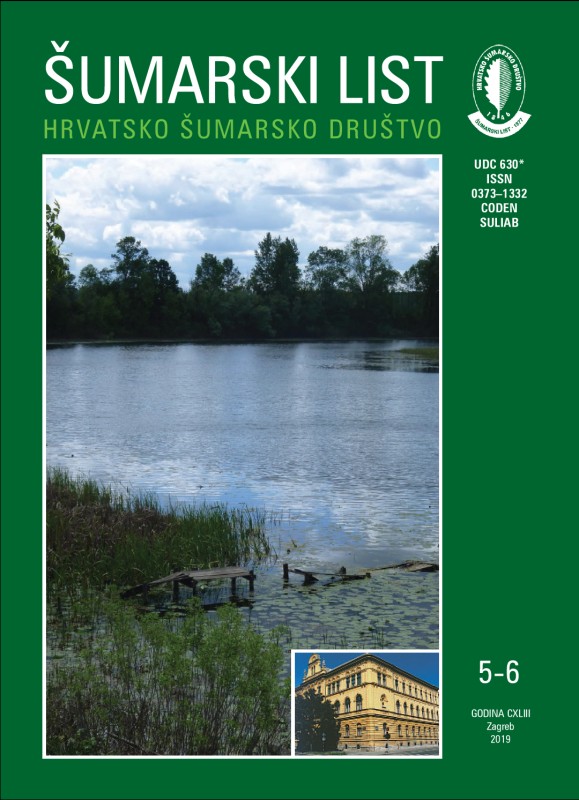
broj: 5-6/2019
pdf (7,52 MB) |
|
||||||||||||||
| IZVORNI ZNANSTVENI ČLANCI | ||
| Krešimir Krapinec, Miroslav Nikolić, Miljenko Bujanić, Dean Konjević | UDK 630* 156 (001) https://doi.org/10.31298/sl.143.5-6.1 | |
| Considerations in the study of trophies: The effect of skull cutting on the real value of roe buck trophies pdf HR EN | 203 | |
| Summary Roe deer is Laurasiatherian mammal from the family of Cervidae. It is autochthonous and one of the most valued trophy game species in Croatia (Zorić 2014.). Antlers (left and right branch) with complete or part of the skull are regarded as trophy. Despite the fact that roe deer antlers are easily accessible trophies, formulas for their evaluations are still largely debated. It is a consequence of large number of elements that need to be evaluated, possible use of coefficient instead of measuring volume and mass, and potential differences in trophy preparation. Guidelines of the International Council for Game and Wildlife Conservation (CIC) instructs that skulls should be cut through the eye cavities leaving intact nasal bones on the trophy. If otherwise cut or left intact with maxillar teeth, deduction of 65 or 90g is foreseen. Considering the fact that weight and density of bones varies between populations, we hypothesize that above mentioned deductions do not represent real values. Therefore the aim of this research was to determine the deviations from actual mass. A total of 40 roe buck skulls originating from the area of Central Croatia were analysed. All skulls were weighed 3 times, initially when intact, after shallow cut and after proscribed cut. Obtained data were statistically analysed. Following the shallow cut, skull is lighter for 25 to 52 g, which is 11 g less than proscribed 65 g. In other words application of shallow cut will result in the loss in trophy value. In cases of intact skulls loss in weight is related to gross skull mass. In this case even 68 to 70% of variability are explained by gross skull mass (R2=0.680; p<0.0001 – linear function, or R2=0.699; p<0.01 – potency function). According to the intersection of the lines (obligate deduction of 90 g and dependence of mass loss due to the cutting) milestone in the mass is at 310 g gross. In other words trophies lighter than 310 g should be cut according to proscriptions as they will lose less than 90 g, while heavier skulls should be left intact as they will lose more than proscribed 90 g. Regardless of the skull preparation, all obtained masses show statistically significant relation to volume. With increase in volume density of trophies decreases (R2=0.813; p<0.001), with the fact that cutting of the skull results in removal of denser, heavier parts of the trophy. Application of the coefficient 0.23 depends on the density of the trophy, meaning that its application in the case of heavier antlers with lower volume will increase the trophy value. In the case of porous antlers the real coefficient should be higher, as application of 0.23 results in lower trophy values. In the case of intact skulls we do not advice application of 0.23 coefficient as this will decrease the trophy value. Key words: antlers; relative weight; weight; trophy evaluation; CIC; roe deer buck | ||
| Milivoj Franjević, Zoran Šikić, Boris Hrašovec | UDK 630* 453 (001) https://doi.org/10.31298/sl.143.5-6.2 | |
| First occurrence of Xylosandrus germanus (Blandford, 1894) – black steam borer in pheromone baited panel traps and population build up in Croatian oak stands pdf HR EN | 215 | |
| Nikola Šušić, Martin Bobinac, Siniša Andrašev, Mirjana Šijačić-Nikolić, Andrijana Bauer-Živković | UDK 630* 232.3 + 815 (001) https://doi.org/10.31298/sl.143.5-6.3 | |
| Growth characteristics of one-year-old Hungarian oak seedlings (Quercus frainetto Ten.) in full light conditions pdf HR EN | 221 | |
| Ayhan Usta, Murat Yilmaz, Selvinaz Yilmaz, Yavuz Okunur Kocamanoglu, Esengül Genc, Ibrahim Turna | UDK 630* 242 (001) https://doi.org/10.31298/sl.143.5-6.4 | |
| The effects of thinning intensity on the growth of oriental beech (Fagus orientalis Lipsky) plantations in Trabzon, NE Turkey pdf HR EN | 231 | |
| Yilmaz Turk, Murat Yildiz | UDK 630* 377 + 424 (001) https://doi.org/10.31298/sl.143.5-6.5 | |
| The effects of wood chips and slash usage on skid trail sheet erosion caused by log skidding using a farm tractor pdf HR EN | 241 | |
| PRETHODNO PRIOPĆENJE | ||
| Kenan Zahirović, Osman Mujezinović, Mirza Dautbašić | UDK 630* 453 https://doi.org/10.31298/sl.143.5-6.6 | |
| First record of parasitod (Platygaster robiniae) on black locust gall midge in Bosnia and Herzegovina pdf HR EN | 251 | |
| STRUČNI ČLANCI | ||
| Ivana Plišo Vusić, Irena Šapić, Joso Vukelić | UDK 630* 181.6 + 187 https://doi.org/10.31298/sl.143.5-6.7 | |
| Identification and mapping of Natura 2000 forest habitat types in Croatia (I) – 91E0*alluvial forest with black alder Alnus glutinosa and common ash Fraxinus excelsior (Alno-Padion, Alnion incanae, Salicion albae) pdf HR EN | 255 | |


